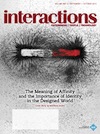Interactions magazine on human nuances
Here are the articles that are currently available for free:
interactions: authenticity, complexity, and design
by Jon Kolko
Frequently, designers find themselves reflecting on the nuances of what makes us human, including matters of cognitive psychology, social interaction, and the desire for emotional resonance. This issue of interactions unpacks all of these ideas, exploring the gestalt of interaction design’s influence.
The meaning of affinity and the importance of identity in the designed world
by Matthew Jordan
When a designer is thinking about ways to create experiences that deliver meaningful and lasting connections to users, it is helpful to consider the notion of our personal affinities and how they affect perception, adoption, and use in the designed world. In our cover story, Matthew Jordan explores the term “affinity,” leading us to consider new and useful ways of informing design thinking and ultimately help us design with more success.
Why “the conversation” isn’t necessarily a conversation
by Ben McAllister
Architects have long understood that the structures we inhabit can influence not only the way we feel, but also the way we behave. This turns out to be true in digital environments like social networks, too. Subtle differences in the underlying structures of these networks give rise to distinct patterns of behavior.
Hope for the best and prepare for the worst: interaction design and the tipping point
by Eli Blevis and Shunying Blevis
Typical interaction designers are not climate scientists, but interaction designers can make well-informed use of climate sciences and closely related sciences. Interaction design can make scientific information, interpretations, and perspectives available in an accessible and widely distributed form so that people’s consciousness is raised.
Gestural interfaces: a step backwards in usability
by Donald Norman and Jakob Nielsen
The new gestural and touch interfaces can be a pleasure to use and a pleasure to see. But the lack of consistency and inability to discover operations, coupled with the ease of accidentally triggering actions from which there is no recovery, threatens the viability of these systems. We urgently need to return to our basics, developing usability guidelines for these systems that are based upon solid principles of interaction design, not on the whims of the company-interface guidelines and arbitrary ideas of developers.
All look same? A comparison of experience design and service design
by Jodi Forlizzi
The comparison of experience design (or UX, as it has been labeled) and service design seems to be a topic of interest in the interaction design community. Can we and should we articulate differences among these fields? Can the methods and knowledge of one successfully transfer to another?
Relying on failures in design research
by Nicolas Nova
The investigation of accidents within a larger process can be inspiring from a design viewpoint. Surfacing people’s problematic reactions when confronted with invisible pieces of technologies highlights their mental model and eventually has implications for design.
Solving complex problems through design
by Steve Baty
What is it about design that makes it so well suited to solving complex problems? Why is design thinking such a promising avenue for business and government tackling seemingly intractable problems?
On academic knowledge production
by Jon Kolko
Now, as design enjoys the corporate credibility of “design thinking†and with the social problems confronting the world growing increasingly intractable, the need for bridging the gap between practitioners and academics is more important than ever.




